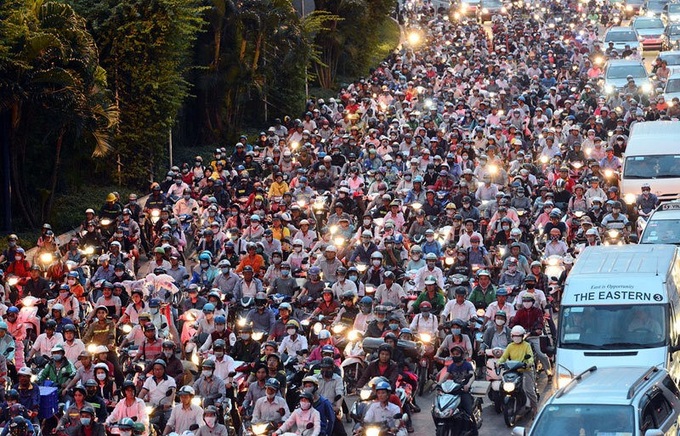
Motorbike is the main means of transport in Vietnam
According to the report about the role of motorbikes in the current and future Vietnam, by the end of 2016, Vietnam had 52 million motorbikes, an increase of 4 million compared to 1995. The motorbike ownership rate is 565 per 1,000 people, and 2.4 per household.
As income per capita increases more people can afford to buy cars. However, despite the increasing number of car owners, the number of motorbikes has never gone down. Over 40% of high earners still use motorbikes on a daily basis.
Motorbikes are cheaper to maintain and much more flexible for short trips. 74% of Vietnamese use motorbikes, 11% use cars and 8% use public buses for the daily commute.
The report pointed out that the infrastructure, especially the average road length in an urban area in Vietnam is too low. This ratio in Seoul, South Korea, is 2,000 metres of road per hectare, 1,800 metres in Tokyo, Japan and 1,500 metres in Jakarta, Indonesia. Meanwhile, Hanoi only has 500 metres of road per hectare.
Both Bangkok and Jakarta has about 1,500 public buses for per a million population. This ratio is 1,000 in Seoul and Guangzhou and only 300 in Hanoi. Not to mention that Hanoi and HCM City still lack metros while Tokyo has over 80 km per a million population, Seoul has over 40 km and Guangzhou has 30 km.
It is estimated that public transports can only meet 1% of demand and are mostly developed in big cities. The report theorised that 70% of the population would still use motorbikes even if annual GDP per capita in 2030 in Hanoi is USD17,000 and USD21,000 in HCM City, the car ownership is 150 per 1,000 people, and there are 600 public buses per a million population.
The report suggested that the authorities should focus on dealing with existing problems such as lack of emission standards, maintenance of motorcycles periodically and low awareness of traffic safety as 14% of the drivers still don't have licenses and only 28% gave correct answers to more than half of the questions about traffic laws.
Traffic lights and lane systems should be revised and driver training courses must be tightened.
Guangzhou authorities in China successfully banned motorbikes but it led to the rapid rise in car owners. In 2014, Guangzhou was listed among 15 most polluted cities in the world and 10 most traffic congested cities in Asia.
31% of asked people in Hanoi believe that the motorbike ban will definitely be carried out while only 12% in HCM City think the ban will be realised.
